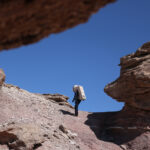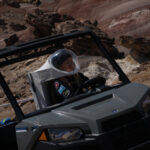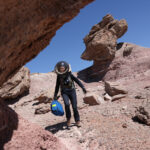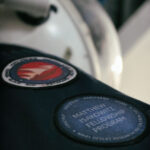“Any feelings of claustrophobia when dealing with tight living quarters/space suits/small habitat?”
Not for me! We have several buildings we have access to. The main one, the Hab, is a two-floor, ~30-foot diameter cylinder. The bottom floor includes the bathroom, washroom, airlocks, spacesuit room, and a common space. The top floor is half our bunks (“staterooms” that are long thing rooms with a bunk bed), and the kitchen. I think the staterooms are the most confined space. You have a narrow hall to go down, and then either have a top or bottom bunk setup (the room interlock so neighboring rooms have either top or bottom). The top bunk is fairly close to the ceiling. I think it would feel constraining if I were claustrophobic but I fit nicely and my only concern is hitting my head if I sit up too fast in the morning!
The other three buildings are the Science Dome, RAM, and GreenHab. The GreenHab is beautiful and warm, and feels incredibly comfortable. It’s a tight space however, and we try not to stay in it if not for a reason. Plus, it gets sweaty.
The RAM is the smallest building and is for engineering and mechanical work and storage. Definitely don’t stay in there long.
Finally, I absolutely adore the ScienceDome. The view of the planet around us is incredible, as there’s a wide window, and it’s spacious and hemispherical, so it feels a bit like a planetarium – which I love!
In reality, 90% of my day not on EVA is spent at the kitchen table, which is the common space we work, eat, and hang out at. However, despite that, I don’t feel too claustrophobic about any of it.
Your mileage may vary though – this is a short-duration Mars trip, the reality may be more challenging.
“How do the space suits you’re using compare to what might actually be used on Mars?”
Although the spacesuits we are using wouldn’t protect us from the radiation or the atmosphere of Mars, they do contain an air filter system and a simulated "oxygen tank" which ups the fidelity for how they feel on EVA. They also include communications between us, so that we are fully on radio comms from the minute we put them on.
“Oddest habit you’ve picked up while on the mission?”
ACK! On the evening before we drove out to the station, we were reading the handbook and preparing for a training quiz. On the section preparing me for my daily reports and emails with CapComm, it noted that you need to “ACK” each email you get, including one immediately at 1900 MT when the Capcomm comes online. That… clearly is indicating you need to “acknowledge” the emails. However, our crew is more creative than that.
We now acknowledge all verbal and written communications with a loud ACK sound, preceded typically by a “Roger Roger.”
An example dialogue:
“Shayna, can you grab the dehydrated potatoes from the cabinet.”
“XO to Crew Botanist, Roger Roger, ACK.”
“Do days feel too planned out sometimes?”
You know, not particularly! I think it’s because although we start the day with a lot of planning and a whole google calendar, by noon, it’s all in constant flux. Whatever problems come up that day dictate how much the schedule changes, and so although we know what we are supposed to do, throughout the day we must adapt and figure out how to prioritize what we need to get done to make the day a success while also handling any spontaneous challenges.
“Do you wear diapers when doing EVAs?”
Nope! Apparently, some crews have brought them to use, though, to preserve the fidelity of the sim. We were informed that after their first time using them on EVA, they immediately stopped and chose to break sim instead for bathroom breaks.
“Is there a Roomba?”
No, clearly we would have one on real Mars, though.
“What are some of the issues you and the team are running into?”
Time and weather! It’s normal for crews to only finish 50% or so of the work they intended to while at the station. Our first week (this is being written on 4/18/21) we encountered significant winds for a few days, making a few EVA’s end early. Because of this, we didn’t have the samples to begin science right away. None of this is abnormal, however it is an indication of the kinds of problems we might face on Mars.
Those Martian dust storms, eh?
“Where does your waste go?”
We have a septic tank which contains liquid and solid waste until they are consumed by bacteria. It’s modeled after the plumbing system of a recreational vehicle (RV), where the waste is stored and then released to a larger septic system.
“Have you seen a monolith out there yet?”
Not yet, but I’m always on the lookout. Never know where those aliens will land, after all.
“Where does your water come from? Is it reusable?”
In this simulation, our water was not reused, however we hope on Mars that it would be! We are given a finite amount of water at the beginning of the simulation from the nearest locality and measure out what daily quantities we feel comfortable using while still retaining a safety buffer. We have found that this is a good practice for learning resource management and conservation and hope to transition to reuse in future analog missions. We take a shower about once a week each!
“What types of tasks fill up the majority of your work time?” and “What does a typical day look like?”
The majority of my time is filled with writing reports! As the Executive Officer, I’ve taken on the tasks of writing our daily Sol Summaries, Commanders’ Reports, and Photo uploads for the Mars Society. Documentation, documentation, documentation! The other tasks that take up my day are going on EVA, acting as Habcomm for other EVA crews, and working on soil sample analysis for my astrobiology study here.
However, the other roles have a variety of other tasks!
The Crew Botanist and Scientist spend a majority of their time monitoring their research in the GreenHab and in the Science Dome. In addition, our Crew Botanist has a talent for cooking, and tends to take lead on mealtimes, with the rest of us acting as sous chefs!
The Commander, in addition to working on larger-scale projects and leadership of the crew, also has a knack for filmography and has run the majority of our media efforts, including the mockumentary we will be putting out.
The Health and Safety Officer, in addition to her role tasks of taking care of crew members, running pre-EVA checks, and writing health reports as necessary, also is doing several experiments in botany and interviews her crew mates about their experiences as analog astronauts.
Last but far from least, the Crew Engineer has potentially the most variable job. He is the handyman extraordinaire of the crew, and not only runs his own experiments in dexterity while wearing spacesuit gloves, but handles the water, power, and septic systems, completing a daily operations report on the functioning of the whole station. His role is absolutely vital, and in my opinion, makes or breaks the success of a crew.
“How immersive have you found the experience to be?”
This experience is exactly as immersive as you make it. On Earth, there are ways to “break sim” whenever you want. You can take off your spacesuit and not, well, die. You can leave a window open. You can bring tons of food with you into sim that in reality you wouldn’t have on Mars. The sim is exactly what you put into it, and MDRS will support you in making it as real of an experience as you can have on Earth.
However, there is significant benefit to not breaking sim. To making sure no skin is exposed to the outside air while on EVA. To not loitering between buildings. To working with dehydrated food and not turning on your phone to google recipes.
Because, while the outside looks like Mars and the inside has the technology first crews on Mars might find themselves with, those are the daily struggles that really drive it home that this isn’t make-believe or pretending.
I am in the process of writing another essay about the immersivity of the analog astronaut experience, I would urge you to check back to read it. I have been personally surprised by how immersive I have found the simulation, even without the gravity change and with the occasional sighting of a bug or critter, and think that the more fidelity you give your own experience, the more you are likely to learn.
Shayna Hume, XO
Red Planet People – MDRS Crew 245 "Team Patamars"To Mars and Beyond – For All!










You must be logged in to post a comment.